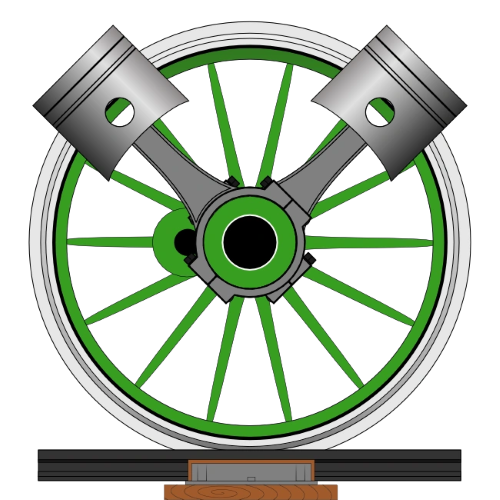East Tennessee & Western North Carolina No. 12 is a 10-26-D class 4-6-0 Ten-Wheeler type steam locomotive built by the Baldwin locomotive works in 1917 for the East Tennessee & Western North Carolina Railway.
The engine used to haul passengers and freight trains over the ET&WNC's 66-mile line running from Johnson City over the Appalachian Mountains to Boone, North Carolina.
The engine ran train service from Johnson City, Tennessee to Boone, North Carolina from 1917 to October 16, 1949, after 32 years of service. The line would continue to operate until October 16, 1950, when the ET&WNC ceased operations of the 3 foot narrow gauge trackage from Elizabethton, TN to Cranberry, NC. The following year, scrapping of the line began and by 1952, the "narr'" gauge portion of the ET&WNC was nothing more than a memory.
In that year, the line began to place the last of the narrow gauge locomotives up for sale, the #9 (Baldwin, 1911), the #11 (Baldwin, 1916), and the #12. The 9 and 11 were sadly scrapped, but #12 was purchased by a group of railroad enthusiasts and was taken to Rockingham County, Virginia to operate as the small "Shenandoah Central" tourist line in 1952. Floodwaters from Hurricane Hazel washed out the Shenandoah Central in 1954, and Locomotive #12 was once again put up for sale. Hollywood actor Gene Autry expressed interest in purchasing the locomotive with the intent to move it to his Melody Ranch in Hollywood, California for use in motion pictures, even purchasing the option (the right to buy it later) to do so. Unfortunately, Autry was quick to learn that moving the locomotive to California would cost much more than the purchase, and ultimately lost interest in the idea. About 1 year later, Autry sold his option to Grover Robbins Jr., a real estate developer who would later start the Tweetsie Railroad in Boone, N.C., For $1. After Robbins' Acquisition of the 12, The locomotive was moved to Hickory North Carolina for restoration. The Tweetsie Railroad opened to the public on July 4, 1957.
When the Tweetsie Railroad theme park opened with its first steam locomotive ride (one mile to a picnic area and back) in 1957, this was its sole locomotive. One year later, in 1958, the line was expanded into a 3-mile loop around "Roundhouse Mountain." It was also around this time that the Wild West Theme was first adopted by the little park, thanks in part to Fred Kirby, a local TV Star who hosted the children's Television block on Charlotte's local PBS Station, WBTV. Kirby decided to celebrate his birthday at the park, So Robbins hired a group of actors to play as Wild Indians and Outlaws to "attack" the train. Surprisingly enough, the scheme worked better than expected, and it became a customary routine for the train ride. This, arguably triggered the park's evolution into the Wild-Western theme park it is today.
In 1999, #12 was given her most extensive overhaul to date, which put her in close to her factory condition, as well as being cosmetically restored to her former "as-built" appearance.
Today the locomotive is still operational at Tweetsie Railroad along side engine #190, a former USATC S118 class 2-8-2 Mikado.
Trivia[]
- No. 12 was the Tweetsie Railroad's first steam locomotive.
- The locomotive is the last surviving narrow-gauge steam locomotive of the East Tennessee and Western North Carolina Railroad.
- Currently, she is the oldest operational steam locomotive in North Carolina.
- During her time at Tweetsie, she has received multiple cosmetic changes over the years. The most notable of which was in the 1960's, when she received a large diamond stack and casing over her headlight to resemble an old-fashioned kerosene headlight, in order for the locomotive to more closely resemble a locomotive from the 1800's. Eventually, these were removed and the locomotive went back to more closely resembling her "as-built" appearance.
- During No. 12's 1980s overhaul, the locomotive's Baldwin 5 inch 3-chime whistle was damaged while it was being moved into the workshop. This resulted in the whistle being given a deep and raspy tone. The whistle would be repaired by the crew around 1995, returning the whistle to it's original sound.
- The Locomotive is the basis of model train manufacturer Bachmann Trains' "Big Haulers" 4-6-0 Ten Wheeler.
- The Locomotive appeared in 2 films, which includes 1963's Red Runs the River, and 2010's Mandie and the Cherokee Treasure
- The Locomotive was featured in the Official Music Video for Going, Going, Gone by Country Music artist Luke Combs.
